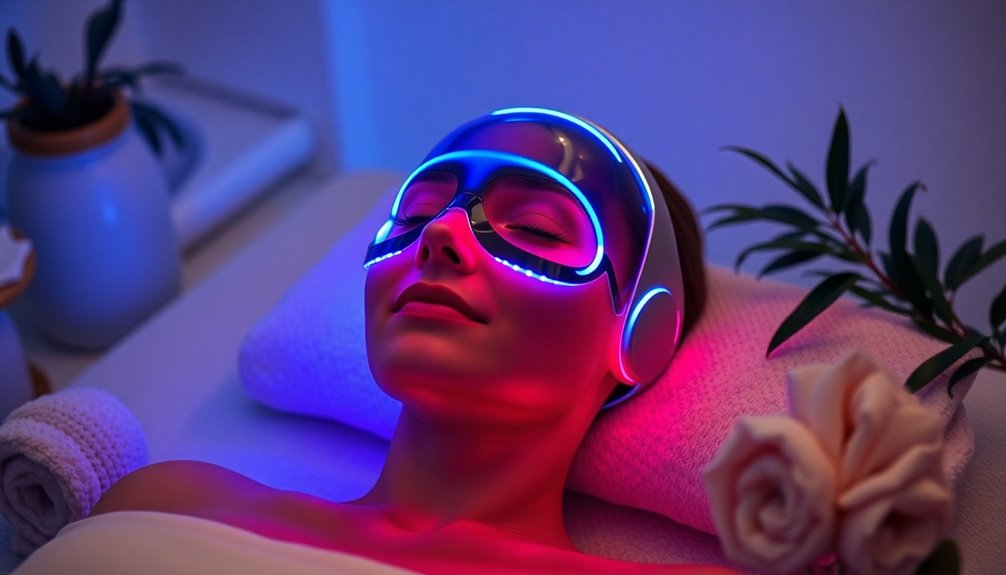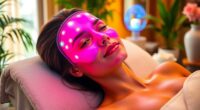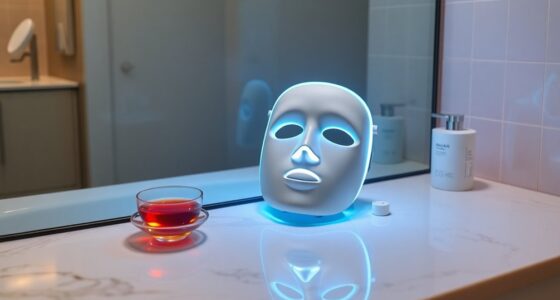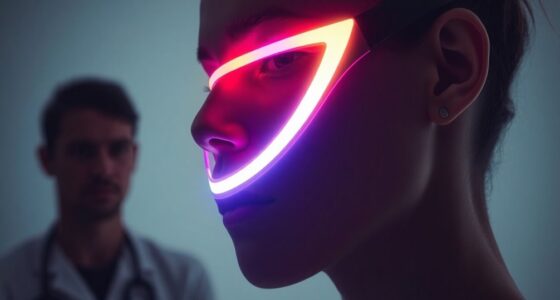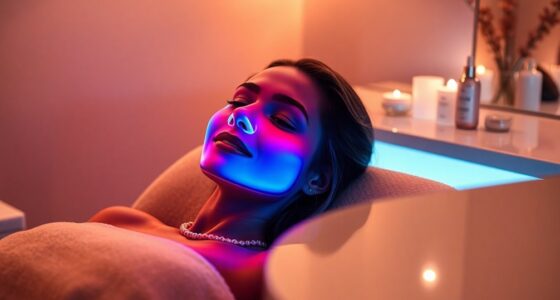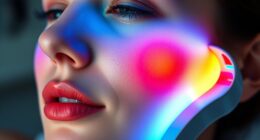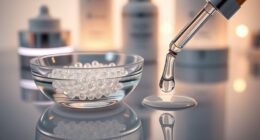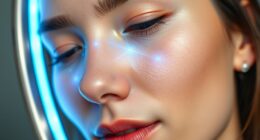LED face masks work by utilizing specific wavelengths of light to target different skin concerns. Red light boosts collagen production and reduces signs of aging, while blue light targets acne-causing bacteria and regulates oil production. You’ll find that near-infrared light promotes healing and decreases inflammation. To see the best results, consistency is key. If you want to know more about their benefits and how to use them effectively, just keep exploring the details!
Key Takeaways
- LED face masks emit specific wavelengths of light that penetrate the skin to stimulate cellular activity and address various skin issues.
- Red light therapy boosts collagen production, enhancing skin elasticity and reducing signs of aging.
- Blue light therapy targets acne-causing bacteria, regulates oil production, and reduces breakouts and inflammation.
- Near-infrared light promotes healing and decreases chronic inflammation, aiding in wound recovery.
- Regular use improves skin texture and blood circulation, with visible results typically observed over 4 to 12 weeks.
Understanding LED Light Therapy
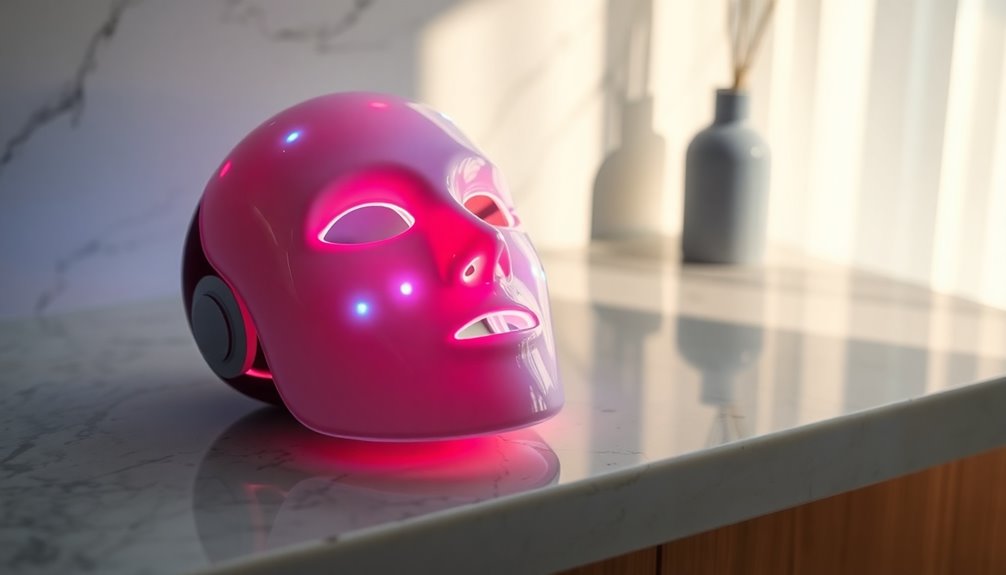
LED light therapy is a groundbreaking approach to skincare that harnesses the power of specific wavelengths of light to address various skin concerns.
By utilizing different colors, such as red and blue, this therapy stimulates cellular activity and boosts collagen production. Red light therapy, with wavelengths between 630 and 660 nanometers, is particularly effective in reducing wrinkles and improving skin elasticity by enhancing collagen and elastin.
On the other hand, blue light therapy targets acne-causing bacteria, helping you reduce breakouts and oil production. Incorporating near-infrared light can further promote healing and decrease chronic inflammation.
With consistent use, LED light therapy not only improves overall skin appearance but also helps treat specific skin concerns effectively.
Mechanism of Action in LED Masks
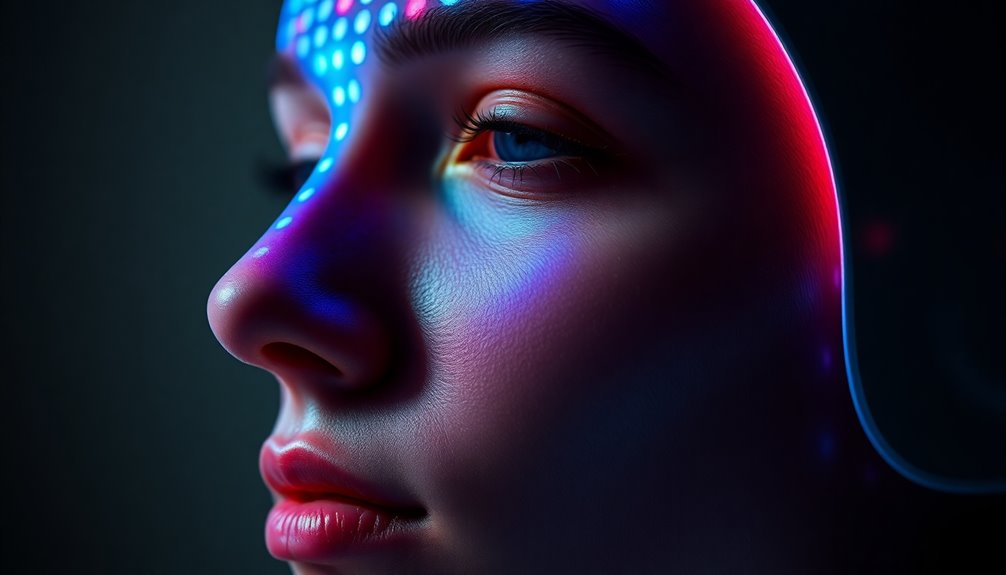
When you use an LED face mask, different light wavelengths target specific skin issues.
For instance, red light boosts collagen production, while blue light fights acne-causing bacteria.
Understanding how these wavelengths stimulate your skin cells can help you maximize the benefits of your treatments.
Light Wavelengths Explained
Understanding how different light wavelengths affect your skin can enhance your experience with LED face masks. Each wavelength serves a unique purpose, targeting various skin concerns. Here’s a breakdown:
| Light Color | Wavelength (nm) | Effect |
|---|---|---|
| Red | 630-660 | Promotes collagen production, reduces inflammation |
| Blue | 405-420 | Targets acne-causing bacteria, decreases oil production |
| Near-Infrared | 800-1400 | Penetrates deeper for tissue repair and recovery |
Cellular Stimulation Process
By harnessing specific light wavelengths, LED face masks stimulate cellular activity in your skin, triggering a series of biochemical reactions.
The red light therapy, with wavelengths from 630 to 660 nanometers, effectively boosts collagen and elastin production, enhancing skin elasticity while reducing fine lines and wrinkles. As you wear the mask, the light penetrates deeply, stimulating fibroblasts to create more collagen, leading to a plumper appearance.
Additionally, blue light therapy targets acne-causing bacteria, helping to minimize breakouts and regulate oil production. Near-infrared light reaches deeper skin layers, promoting wound healing and reducing inflammation.
Regular use of LED masks results in improved blood circulation, increased hydration, and an overall revitalized skin texture and tone. Additionally, these innovative devices help stimulate collagen production, which can reduce the appearance of fine lines and wrinkles. As a result, users often report a more youthful and radiant complexion. With consistent application, the led masks benefits for skin can be remarkably transformative, making them a valuable addition to any skincare routine.
Different Wavelengths and Their Effects
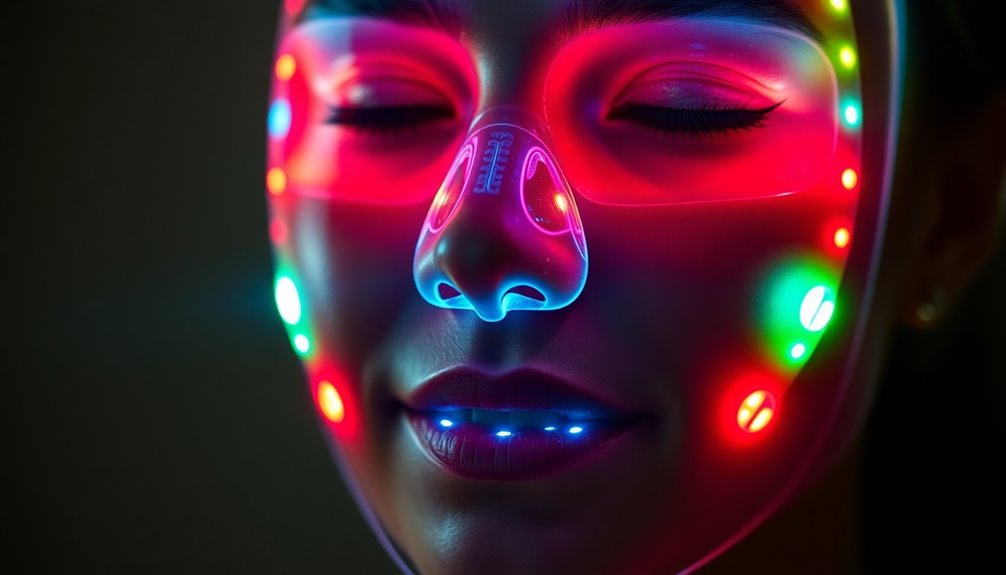
Have you ever wondered how different wavelengths of light can dramatically affect your skin? LED face masks utilize specific wavelengths of light to target various skin concerns. For example, red and near-infrared light stimulate the production of collagen and elastin, making your skin look youthful. On the other hand, blue light helps reduce inflammation and targets acne-causing bacteria. Here’s a quick overview of their effects:
| Wavelength | Effect | Targeted Issue |
|---|---|---|
| Red (630-660 nm) | Stimulates collagen production | Signs of aging |
| Near-Infrared (800-1400 nm) | Enhances wound healing | Reduces inflammation |
| Blue (405-420 nm) | Reduces oil production | Acne |
Understanding these wavelengths helps you choose the right treatment for your skin needs.
Red Light Therapy Benefits
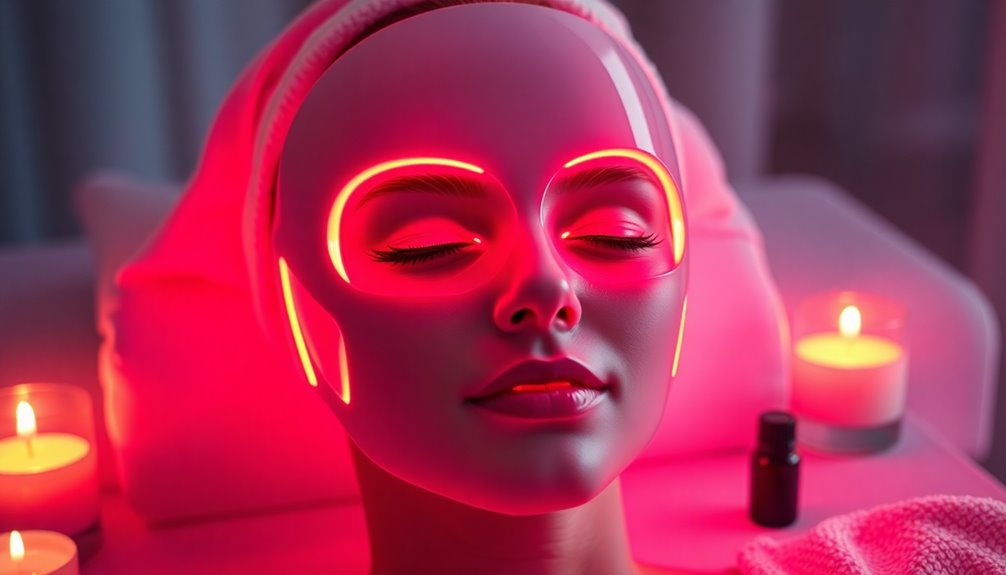
Red light therapy offers remarkable benefits for your skin, especially if you’re looking to reduce signs of aging.
By utilizing wavelengths between 630 to 700 nanometers, it penetrates deeply, stimulating collagen and elastin production. This boost enhances your skin’s strength and elasticity, helping to reduce wrinkles and fine lines effectively.
Regular use of red light therapy promotes skin rejuvenation by improving overall texture and reducing inflammation, which accelerates healing. You might notice significant improvements in conditions like acne scars and photoaging, making your complexion look more youthful.
Dr. Akshay Sanan, a facial plastic surgeon, endorses this therapy for its effectiveness in rejuvenating skin and minimizing the visible effects of aging.
Embrace red light therapy for a vibrant, youthful glow!
Blue Light Therapy Benefits
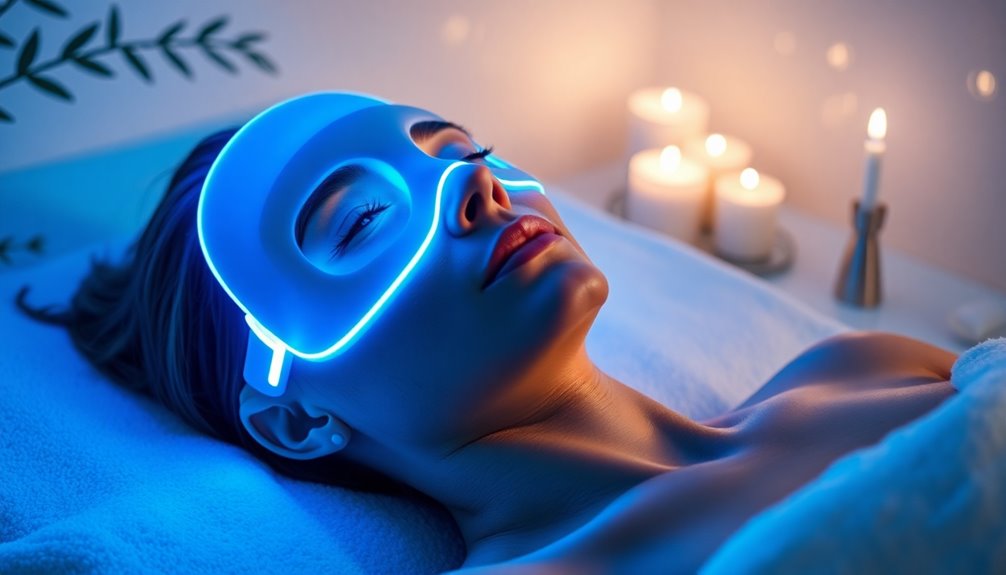
If you’re struggling with acne, blue light therapy might be the solution you need. This innovative treatment targets acne-causing bacteria with wavelengths between 405 and 420 nanometers, helping to reduce breakouts effectively.
Not only does it kill these bacteria, but blue light therapy also boasts anti-inflammatory properties that calm irritated skin and minimize redness. Regular use can lead to a significant reduction in acne lesions and an overall improvement in your skin’s texture.
Plus, it regulates oil production, making it ideal for those with oily or combination skin. Best of all, blue light therapy is non-invasive, posing no risk of skin damage or tanning, ensuring a safer approach to treating acne.
Near-Infrared Light and Its Healing Properties
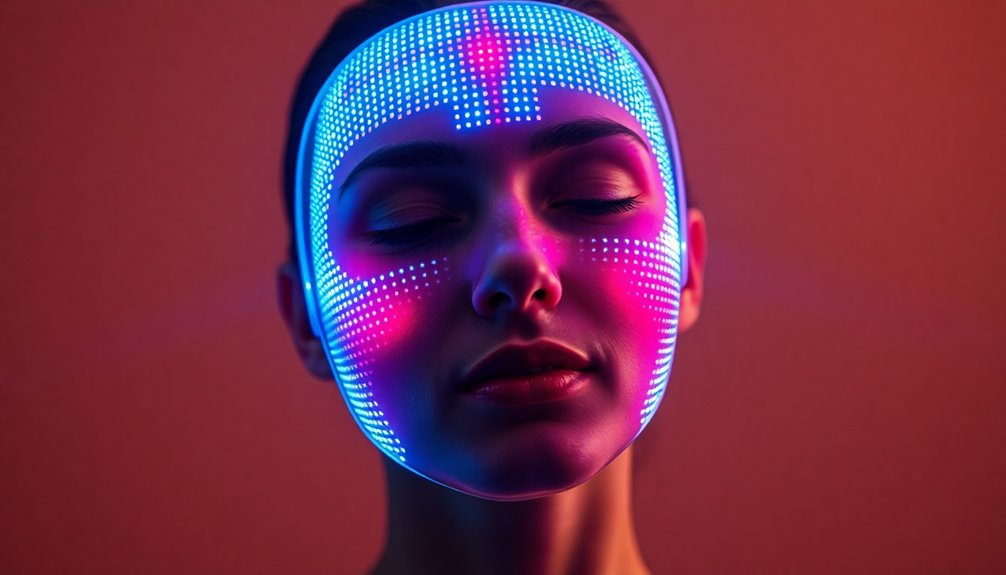
Near-infrared light therapy offers powerful healing benefits for your skin.
It promotes wound healing, reduces chronic inflammation, and enhances skin recovery, making it a valuable addition to your skincare routine.
Promotes Wound Healing
While many people seek quick fixes for skin issues, understanding how near-infrared light (NIR) promotes wound healing reveals its powerful benefits.
NIR, with wavelengths around 700 nanometers or more, penetrates deeply into your skin, stimulating cellular activity and enhancing tissue regeneration. This process is vital for effective wound healing and skin recovery, as it increases blood flow and oxygenation to the affected areas.
Experts, including Dr. Akshay Sanan, endorse NIR light therapy for its ability to accelerate healing and improve overall skin texture.
By regularly using LED devices that emit near-infrared light, you can experience cumulative benefits, leading to improved skin health and resilience over time.
Embracing this technology can greatly enhance your skin recovery journey.
Reduces Chronic Inflammation
Chronic inflammation can be a persistent issue for many, but near-infrared light therapy offers a promising solution.
When using LED Face Masks that emit near-infrared light, you can effectively reduce inflammation in deeper skin layers. This therapy stimulates cellular repair, enhances blood circulation, and improves oxygenation, all essential for healing.
Studies show that near-infrared light greatly reduces inflammation associated with skin conditions like rosacea and psoriasis, leading to better overall skin health and appearance.
By regularly using these masks, you can experience cumulative benefits, enhancing your skin’s resilience and minimizing the frequency and severity of inflammatory flare-ups.
This targeted approach makes LED Face Masks an excellent choice for anyone struggling with chronic inflammation.
Enhances Skin Recovery
LED Face Masks not only reduce chronic inflammation but also play a significant role in enhancing skin recovery. The near-infrared light in these masks penetrates deeply, promoting healing and improving damaged skin tissues.
Here’s how it works for your skin:
- Accelerates Healing: Near-infrared light speeds up skin recovery from ailments and procedures.
- Reduces Inflammation: It helps in lowering chronic inflammation, leading to better skin health.
- Stimulates Collagen Production: This light boosts collagen and elastin, essential for skin strength and elasticity.
- Improves Appearance: Enhanced collagen leads to a more youthful, radiant look.
Recommended Usage and Best Practices
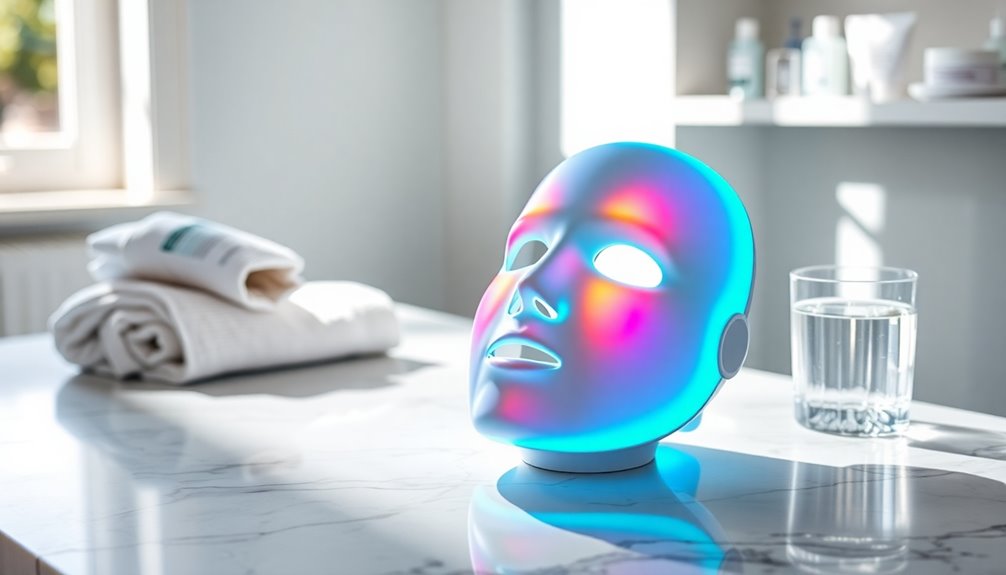
To get the most out of your LED face mask, start by ensuring your skin is clean and dry, as this allows the light therapy to penetrate effectively.
For recommended usage, adhere to the device-specific session times, typically between 3 to 10 minutes. Consistency is key—aim for five sessions a week for at least a month to see visible improvements.
After each treatment, apply hydrating skincare products to enhance the benefits.
While LED masks are safe to use, avoid combining them with retinoids to prevent irritation.
Expected Results and Timeline
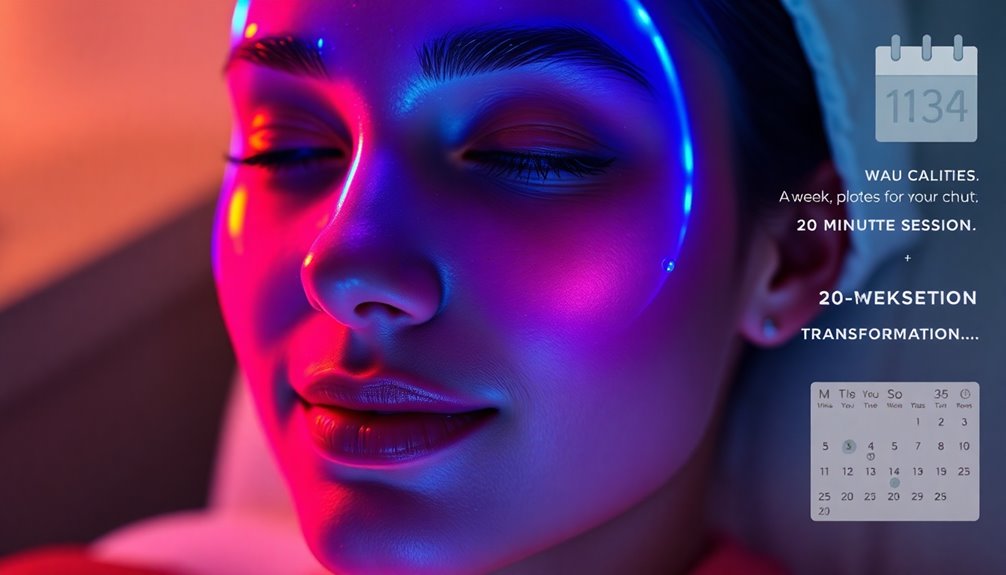
After following the recommended usage and best practices, you might wonder what results to expect and when. While immediate results are rare, you can anticipate:
- Improved Skin Texture: Noticeable changes in smoothness and glow.
- Reduced Wrinkles: Visible effects may take time, but benefits accumulate.
- Accelerated Acne Healing: Enhanced recovery from breakouts over time.
- Personalized Timeline: Expect significant changes in 4 to 12 weeks, influenced by your skin type and chosen LED wavelengths.
Documenting your progress with photos can help you track these changes and maintain motivation.
Safety and FDA Clearance
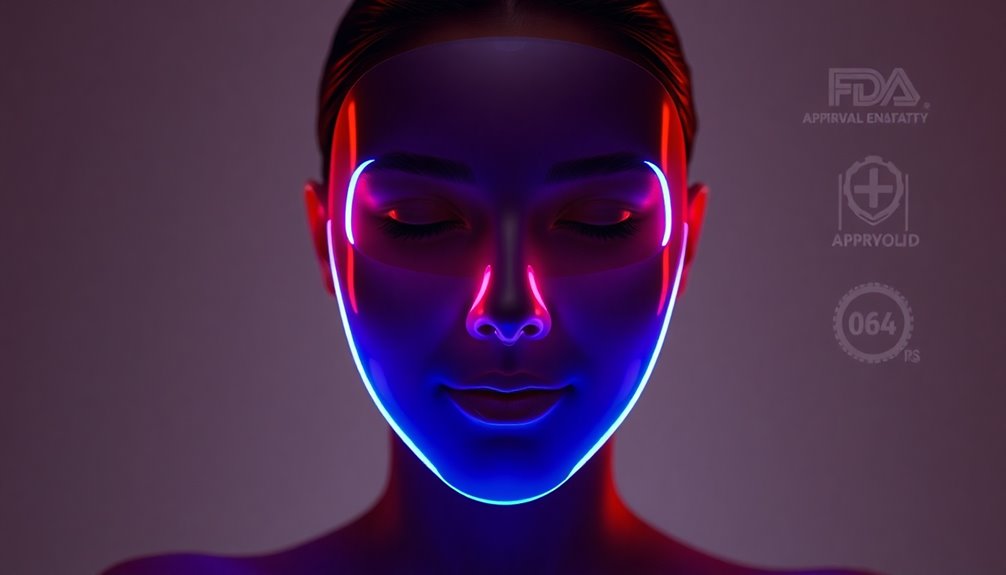
When using LED face masks, it’s important to be aware of potential risks and side effects, like irritation or increased inflammation.
While these devices haven’t received FDA approval, many have FDA clearance, guaranteeing they meet safety standards.
Always follow the manufacturer’s instructions and consider eye protection, especially with blue light treatments, to secure a safe experience.
Risks and Side Effects
While LED face masks are generally safe for most users, it’s crucial to be aware of potential risks and side effects. Here are some important considerations:
- Light Sensitivity: If you have light sensitivity, consult a dermatologist before using the mask.
- Eye Protection: Always wear eye protection, especially during blue light treatments, to prevent eye damage.
- Skin Irritation: Overusing the device or not following guidelines can lead to irritation, redness, or increased inflammation.
- Monitor Reactions: Long-term safety data is limited, so keep an eye on your skin’s response and stop use if you notice any adverse reactions.
Staying informed will help you enjoy the benefits of LED masks while minimizing risks.
Importance of FDA Clearance
Understanding the importance of FDA clearance is vital for anyone considering an LED face mask. FDA cleared devices have undergone rigorous testing to prove their safety and efficacy for at-home LED use.
This clearance guarantees that the mask meets established safety standards, giving you confidence in your purchase. Currently, no LED face masks have received full FDA approval, so it’s important to verify clearance status before buying.
Devices with FDA clearance have been evaluated for risks and benefits, helping to mitigate potential adverse effects. To confirm you’re using a safe and effective product, consumers are encouraged to check the FDA database for cleared devices.
This simple step can make all the difference in your skincare routine.
Recommended Safety Precautions
Before diving into your LED face mask routine, it’s crucial to take some recommended safety precautions to assure a positive experience.
Follow these guidelines to guarantee your safety and effectiveness:
- Check for FDA Approval: Make sure your LED face mask is FDA-cleared to meet safety standards.
- Use Eye Protection: Always wear eye protection, especially when using blue light, to prevent potential damage to your eyes.
- Consult a Dermatologist: If you have sensitive skin or specific conditions, talk to a board-certified dermatologist before starting treatments.
- Follow Instructions: Carefully read the manufacturer’s instructions to avoid misuse and minimize potential side effects like irritation or redness.
With these precautions, you can enjoy your LED face mask routine safely!
Comparing Professional vs. At-Home Treatments
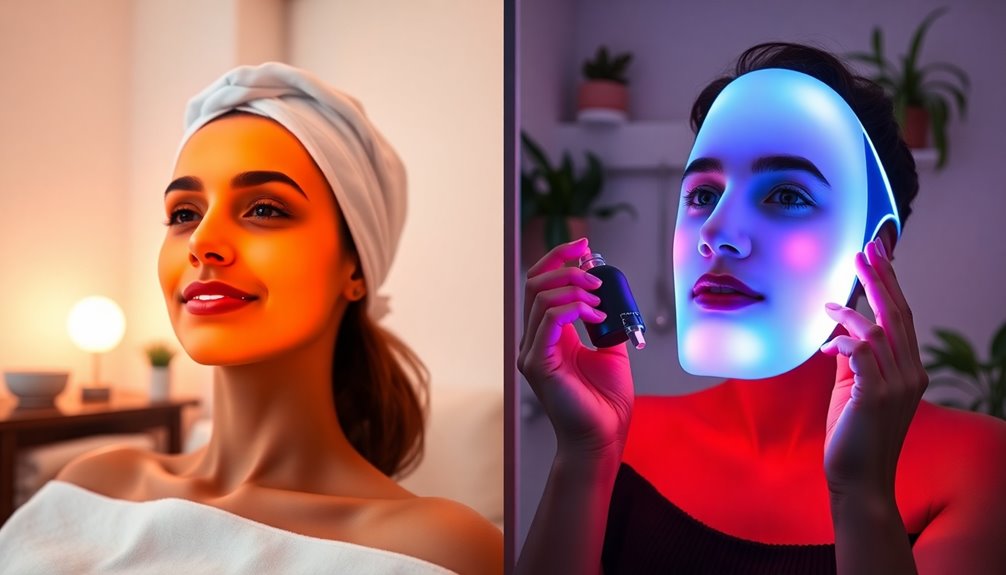
When it comes to LED face masks, you’ll find a significant difference between professional treatments and at-home options.
Professional treatments usually use more powerful devices, leading to quicker and more pronounced results. You might notice subtle improvements after just a few sessions.
In contrast, at-home masks offer convenience and affordability, but they often require consistent use over weeks or months for noticeable changes.
While many at-home masks lack FDA clearance, professionals utilize devices that are proven safe and effective.
Additionally, trained technicians can customize treatments based on your skin type, while at-home options typically feature preset modes that may not address your specific needs.
Weighing these factors can help you decide which route suits you best.
Frequently Asked Questions
Does the LED Face Mask Really Work?
You might wonder if LED face masks really work.
Many users report subtle improvements in skin texture and a reduction in wrinkles after regular use. However, results can vary based on the device’s quality, your skin type, and how often you use it.
While they’re generally safe, overuse can lead to irritation. For the best results, follow the manufacturer’s guidelines and consider consulting a dermatologist for personalized advice.
What Are the Disadvantages of a LED Mask?
Using an LED mask might feel like you’re stepping into a sci-fi movie, but it has its downsides.
You could experience skin irritation or redness, especially if you overdo it. The results are usually subtle compared to professional treatments, and long-term safety is still a mystery.
If you’ve got sensitive skin, it’s smart to check with a dermatologist first. Plus, those masks can cost a fortune, often leaving you wondering about their true value.
What Does Mayo Clinic Say About Red Light Therapy?
The Mayo Clinic recognizes red light therapy as a non-invasive treatment utilizing specific wavelengths to promote healing and improve skin conditions.
It can enhance collagen production, improving skin elasticity and reducing wrinkles. You might find it helpful for reducing inflammation and accelerating healing for issues like acne and sun damage.
However, remember that individual results can vary, and it’s best to consult a healthcare professional before starting any new therapy.
How Long Does It Take LED Face Mask to Work?
Imagine stepping into a futuristic spa, where glowing lights promise rejuvenation.
You might wonder how long it’ll take for an LED face mask to work. Generally, you’ll need to commit to about four to six weeks of consistent use to see visible improvements.
After two weeks, you could notice subtle changes, but significant results often take longer.
Aim for five sessions a week, lasting 10 to 20 minutes each, and patience pays off!
Conclusion
So, you thought glowing like a light bulb was just for holiday decorations? Well, with LED face masks, you can actually do it for your skin! Embracing this high-tech beauty trend might just make you the envy of the neighborhood. While you’re busy zapping away imperfections, remember—self-care’s not just a fad; it’s a chance to shine. Who knew looking radiant could be as easy as lounging around in a sci-fi movie prop? Enjoy your newfound glow!
